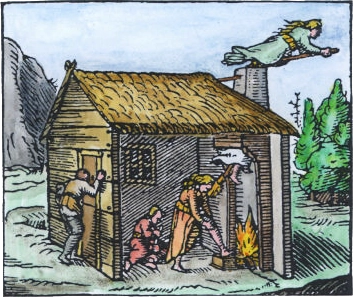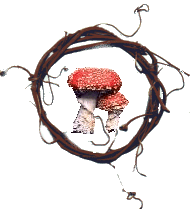Dame Alice Kyteler

Dame Alice Kyteler An Abstract on Kilkenny’s Sorceress of Auld
But now wind drops, dust settles; thereupon
There lurches past, his great eyes without thought
Under the shadow of stupid straw-pale locks,
That insolent fiend Robert Artisson,
To whom the love-lorn Lady Kyteler brought
Bronzed peacock feathers, red combs of her cocks.W.B. Yeats, Nineteen Hundred and Nineteen
Dame Alice Kyteler (pronounced Kettler), unknown to many who practice Witchcraft today has in important place in the annals of Witchcraft history. Born in Kilkenny Ireland, Lady Alice or Dame Alice as she was also known was one of the first to be formally tried by the Catholic Church for Sorcery in 1324. Her crime? The Bishop of Ossory, Richard Ledrede, claimed that she and eleven of her family and friends (see list of names below) had transgressions of numerous supernatural types ranging from being heretics to having nocturnal meetings with the Devil himself among the other Unhallowed Artes they practiced.
She, Dame Alice, was also known to have a Magistellus or Demon/Familiar (called Robinus Filius Artis, Robin Artisson or Robin, Son of Art) that came to her in the form of an animal, sometimes in the form of a cat and sometimes in the form of a large black, shaggy dog, and at times even in the form of a black man who was attended by two swarthy servants that carried iron rods. It is with the primary demon Robin, considered to be from the poorer classes of hell, that Dame Alice had sexual congress and from whom she exacted all her wealth.
She and her friends and family were suspected to have both aroused feelings of love and of hatred, and to have inflicted death or disease on the bodies of the faithful (Christians) by making use of powders, unguents, ointments, and candles of fat, which were compounded as follows. They took the entrails of the eyes of peacocks, whole red cocks, certain worms, spiders, scorpions and various unspecified herbs (millefoil is one that was thought to have been used), dead men’s nails, the hair, brains, and shreds of the cerements of boys who were buried unbaptized, with other ingredients. All of this was then cooked with various incants spoken aloud over a fire of oak-logs in a vessel made out of the skull of a beheaded thief. Other items used in Lady Alice’s sorceries were sacramental wafers that had been stamped with the name of the devil.
Records indicate that Dame Alice compelled contact and attendance with this fairy/demon Robin by sacrificing nine red cocks and offering up the eyes of nine peacocks at the center of a crossroads that was near a certain stone bridge. In exchange for her welcome gifts he (Robin) gave her a small pot of ointment or a type of unguent by which she was to use to travel and meet him and other Witches for the celebration of the Sabbath at a place named the Devil’s Bit in the county of Tipperary.
It was discovered that when Lady Alice went to these meetings that she often left behind in her stead (in bed next to her husband that is) the wooden branch or pole (called a coulter/cowltre by Lady Alice) that she had anointed with this ointment. Robin also was instrumental in aiding Lady Alice by sweeping the local streets of filth and bringing it the doorstep of her son, which he used as manure. Lady Alice was also seen having demonstrated similar activities herself while muttering some sort of charm under her breath that would bring additional monetary benefits to her and her already wealthy family. “To the House of William my Sonne, Hie all the Wealth of Kilkennie Towne.”
Dame Alice was accused by the children of her former husbands of beguiling their Fathers with sorcery and hastening their deaths by her scandalous acts and deeds which left the children destitute and impoverished. Despite the Bishop’s request that the Dame be arrested for her crimes she was left unpunished for the time being. When Bishop Ledrede did not achieve the satisfaction he desired and found his plans thwarted by Sir Arnold le Poer, the Seneschal of Kilkenny (who was probably a distant relation to Alice’s fourth husband) he took matters into his own hands and demanded her to appear before him. Dame Alice, as would have been anticipated, fled instead.
Foiled again, the Bishop then cited her son William for heresy. After being besought by le Poer to discontinue the matter the tables were turned on the Bishop and he was eventually imprisoned by Stephen le Poer, bailiff of Overk, and an armed posse of men. After being detained for 17 days, the Bishop was released where he continued his reign of harassment. The Bishop had the audacity to again issue a writ demanding that William appear before him but was unable to fulfill that obligation as the Bishop was called to appear himself before his own diocese in Dublin (which he neatly sidestepped claiming that to get there he must travel through Sir Arnold’s lands and that would endanger his very life).
The Bishop did eventually make his way there to answer to the charges that he had excommunicated Dame Alice, but found that his charges were uncited, unadmonished, and she remained unconvicted of the crime of sorcery. Although Sir Arnold was indeed humbled and a sort of peace was restored temporarily. After finding satisfaction during this latest barrage of charges, the Bishop once again tried to have the Dame seized by the Chancellor as well as the Vicar-General of the Archbishop of Dublin. Once again, Dame Alice fled, this time from Dublin, and made her way to England where she spent the rest of her days in relative peace.
Unfortunately, for Petronilla Meath, Alice’s maid and confidante, Fate would not be as kind. She was ordered flogged by the Bishop and even after confessing that she too was a worker of the Black Artes, though not nearly as beneficent at them as the Dame, Petronilla was made a scapegoat in the worst possible fashion. In the public confession she made before her death, Petronilla acknowledged Dame Alice as her mistress and her teacher in these arts and claimed that there were none as skilled as Lady Alice in these practices of sorcery.
Petronilla claimed to have been present when Lady Alice met with the demon Robin and claimed that Dame Alice and Robin shared a sexual congress among other actions during their nightly conventicles. Petronilla also gave a glimpse of insight to the subsequent reactions that occurred after utilizing the ointment they had prepared, often it made the women who had used it to appear to have horns like goats. The Bishop ordered her death by fire and on 3rd November 1324, in Kilkenny, Petronilla was burnt alive, this being the first case of a death by fire for the crime of heresy. Petronilla’s young daughter was shipped to England after her Mother’s death and subsequently raised by Dame Alice.
Before it was all done and over with even Sir Arnold le Poer, who had taken such a prominent part in the affair, was attacked. The Bishop accused him of heresy as well, then had him excommunicated, and sent to prison at Dublin Castle. The Bishop himself did not fare well and suffered from the accusation of heresy himself brought upon by his Metropolitan, Alexander de Bicknor. He (the Bishop) endured a long exile from his diocese, suffered much personal hardships, and even had his temporalities seized by the Crown as well. In 1339 his royal favour was restored but ten years later additional accusations were brought before the King against in consequence of which the temporalities were a second time taken up, and other more severe measures were threatened.
The Bishop died in 1360 leaving behind a veritable wake of disturbances. Some information taken from Irish Witchcraft and Demonology. For more information, see Harley MS 641, The History of Magic by Joseph Ennemoser, The Witch Cult in Western Europe by Margaret Murray, Narratives of Sorcery and Magic by Thomas Wright, Ireland Picturesque and Romantic by Leitch Ritchie.
- Alice Kyteler
- Alice, wife of Henry the Smith
- Annota Lange
- Eva de Brounstoun
- Helena Galrussyn
- John Galrussyn
- Petronilla de Meath
- Robert de Bristol
- William Outlaw
- Sarah, daughter of Petronilla
- Sysok Galrussyn
- William Payn of Boly
- Robin, son of Artis (Artisson) — the Devil

Across the woods, beyond the hedge,
We gather at the compass edge.
Lilith’s lantern shining bright,
To guide us in our Witching rite.Wild winds turn Hamlet’s mill,
Will to bid and bid to will.
Kith and kin join hearts and hand,
Power raised where we do stand.We call forth now a Faery beast
From North and South, and West and East.
With ears of red and coat of white,
Guard and protect this darksome night.By stang and cord, cauldron and bell,
By words of writ and song of spell.
By springfed drop and smoky flame,
I invoke thee of the Hidden Name.To join with us this Hunter’s Moon,
So we may seek thy magic boon.
Pale Faced Dame, and Dark Horned God,
Please Join Us in our Faery Trod!© Dawn R. Jackson

